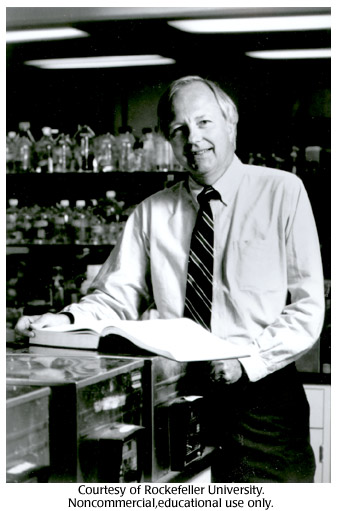Concept 35 DNA responds to signals from outside the cell.
 James Darnell studied how chemical signals turn eukaryotic genes on and off.
James Darnell studied how chemical signals turn eukaryotic genes on and off.
James E. Darnell, Jr. (1930-)

Jim Darnell was born in Columbus, Mississippi — an impoverished region near the Alabama border — on September 9, 1930. His mother was a dietician, and young Jim saw medicine as a way to get out of the South. He raced through college at the University of Mississippi in three years, then worked at the local Air Force base for nine months to raise money for medical school. In 1951, he started studying for his M.D. at Washington University in St. Louis.
Because science news was not well reported in the '40s and '50s, Darnell got his first exposure to lab work in medical school. He was drawn to microbiology; it was a subject where investigators had some control over their subjects. He tried to infect mice with a strain of streptococcus in his first experiments but failed. He had better success infecting rabbits and wrote up the results in his first set of papers. At the time, streptococcus infections produced lesions on the heart, but this disease virtually disappeared after the discovery of penicillin.
After receiving his medical degree and interning for a year, Darnell went to Harry Eagle's lab at NIH under a M.D.-to-scientist training program. Eagle was developing ways to culture human and mouse cells and set Jim to work on studying the biochemistry of animal viruses. Knowing next to nothing about animal viruses, Darnell was fortunate to share his lab bench with Salvador Luria's third graduate student who taught him everything he needed to know to study the polio virus.
After a brief sojourn in Paris to work in François Jacob's lab, Darnell worked at MIT, the Albert Einstein College of Medicine, and Rockefeller University on the relationship between mRNA and hnRNA. hnRNA was believed to be the precursor to mRNA, and despite making some key discoveries, Darnell admits that he could not free his imagination from the idea of colinearity and envision an hnRNA spliced to produce a smaller mRNA.
At this time, Darnell turned his attention to the question he had pondered since Paris: how were genes regulated in animal cells? This led to the discovery of the STAT and the Jak-STAT pathway of transcription control. In 2002 he received the National Medal of Science, and in 2004 was elected a foreign member of the Royal Swedish Academy of Sciences.
In his spare time, Jim Darnell is an avid tennis player and, despite serving on the Cold Spring Harbor Board of Trustees, has never played Cold Spring Harbor's most famous tennis player, Jim Watson. In his early days, he played the clarinet and he still enjoys listening to music. He and his wife, Jane, have three sons: the oldest working in money management, the middle in science, and the youngest, inheriting his left-wing tradition, in public interest research.


Jim Darnell's wife, Jane, came up with the name STAT during a drive home to New York City. The term reminded her of an urgent call over hospital loudspeakers, and accurately reflects the molecule's speed in activating transcription.

Why does it take so many molecules to transfer a message to a cell's nucleus?
 DNA is packaged in a chromosome.
DNA is packaged in a chromosome. Higher cells incorporate an ancient chromosome.
Higher cells incorporate an ancient chromosome. Some DNA does not encode protein.
Some DNA does not encode protein. Some DNA can jump.
Some DNA can jump. Genes can be turned on and off.
Genes can be turned on and off. Genes can be moved between species.
Genes can be moved between species. DNA responds to signals from outside the cell.
DNA responds to signals from outside the cell. Different genes are active in different kinds of cells.
Different genes are active in different kinds of cells. Master genes control basic body plans.
Master genes control basic body plans. Development balances cell growth and death.
Development balances cell growth and death. A genome is an entire set of genes.
A genome is an entire set of genes. Living things share common genes.
Living things share common genes. DNA is only the beginning for understanding the human genome.
DNA is only the beginning for understanding the human genome.